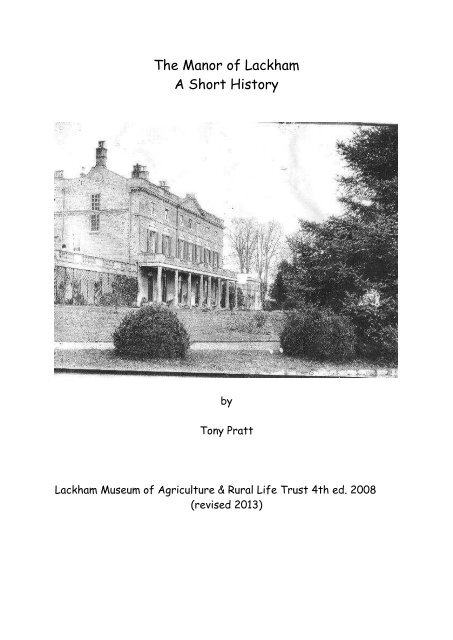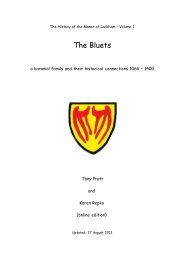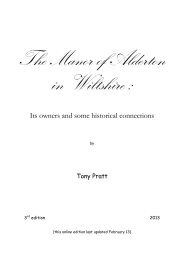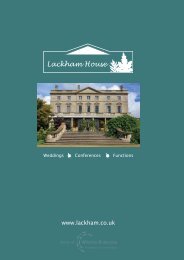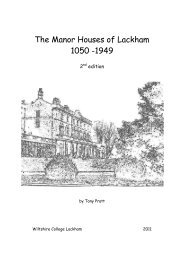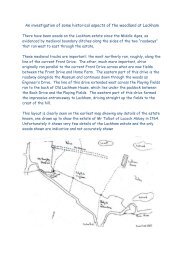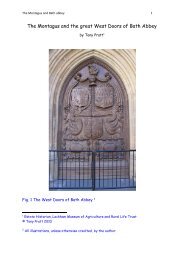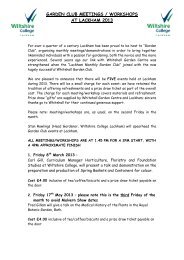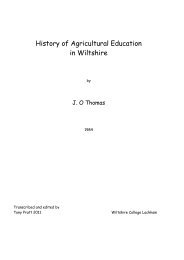The Manor of Lackham A Short History - Lackham Countryside Centre
The Manor of Lackham A Short History - Lackham Countryside Centre
The Manor of Lackham A Short History - Lackham Countryside Centre
You also want an ePaper? Increase the reach of your titles
YUMPU automatically turns print PDFs into web optimized ePapers that Google loves.
<strong>The</strong> <strong>Manor</strong> <strong>of</strong> <strong>Lackham</strong><br />
A <strong>Short</strong> <strong>History</strong><br />
by<br />
Tony Pratt<br />
<strong>Lackham</strong> Museum <strong>of</strong> Agriculture & Rural Life Trust 4th ed. 2008<br />
(revised 2013)
<strong>The</strong> estate <strong>of</strong> <strong>Lackham</strong>, situated on the western bank <strong>of</strong> the Bristol<br />
Avon just outside the Wiltshire market town <strong>of</strong> Chippenham, has a long<br />
recorded history. In the immediate vicinity there is evidence <strong>of</strong> Stone Age,<br />
Bronze Age and Roman occupation. Parts <strong>of</strong> 3rd and 4th<br />
century Roman querns (used for grinding corn) and ro<strong>of</strong>ing tiles have been<br />
found, and Romano-British field boundaries were found<br />
underneath the medieval House.<br />
In the early mediaeval (Saxon) period it was part <strong>of</strong> the estates <strong>of</strong> one <strong>of</strong> the<br />
richest <strong>of</strong> the Wiltshire thegns, Aelfstan <strong>of</strong> Boscombe. He was a counsellor and<br />
favourite <strong>of</strong> Edward the Confessor (c1003 - 1066) throughout his reign.<br />
<strong>The</strong> d’Eu family<br />
After the Norman Conquest, at the time <strong>of</strong> Domesday, the <strong>Manor</strong> was held by<br />
William d’Eu, the son <strong>of</strong> the Count <strong>of</strong> Eu who later held the title himself, for a<br />
time.<br />
William d’Eu & Edward <strong>of</strong> Salisbury are believed to have replaced the Saxon<br />
church at Lacock with a Norman one, the remains <strong>of</strong> which came to light when<br />
the present church was restored in 1861.<br />
William was involved in a rebellion in 1087 but was dealt with leniently by the<br />
King, so much so that in 1088, he entertained William I , “and a large gathering<br />
<strong>of</strong> the leading magnates at his <strong>Manor</strong> <strong>of</strong> <strong>Lackham</strong>”.<br />
He rebelled again in 1095 and William (Rufus) II, not being as forgiving as his<br />
father, or maybe thinking twice was one rebellion too many, dealt harshly with<br />
the rebels; <strong>The</strong> Anglo Saxon Chronicle tells that<br />
“Ge<strong>of</strong>fery Bainard accused William d’Eu, the Kings kinsman, <strong>of</strong><br />
treason and maintained his charge in single combat: and William<br />
being vanquished, the King ordered him to be blinded and<br />
emasculated”<br />
Nothing further is heard <strong>of</strong> William d’Eu and it is likely he died <strong>of</strong> his<br />
wounds very soon afterwards.<br />
William held land in many places throughout the country and <strong>Lackham</strong><br />
itself, along with several other Wiltshire and Gloucestershire manors,<br />
were held from him by the Bluet Family, and they continued to hold
their estates after William’s demise, now from the de Clare family who<br />
had been given the land by the King.<br />
<strong>The</strong> Bluet family<br />
<strong>The</strong> Bluet family<br />
<strong>The</strong> Bluet family seat was at Silchester in Hampshire 1 and they held may<br />
manors in the south west and Marches, being some <strong>of</strong> the more important<br />
Marcher barons. Bluet’s who held <strong>Lackham</strong> fought for the King in France,<br />
Ireland, Wales and Scotland in various conflicts. <strong>The</strong> <strong>Lackham</strong> line also held<br />
Daglingworth and Duntisborne, just outside Cirencester as well as Yeovilton and<br />
Hinton Blewett. <strong>The</strong> Bluets held <strong>Lackham</strong> for two hundred years, until the<br />
middle <strong>of</strong> the fourteenth century. <strong>The</strong> only surviving Bluet, Eleanor had married<br />
Edmund Baynard for Dunmow in Essex about 1349 and <strong>Lackham</strong> passed to the<br />
Baynards. 1<br />
<strong>The</strong> Baynard family, the<br />
<strong>Lackham</strong> branch <strong>of</strong> the<br />
family used a slightly<br />
different version<br />
<strong>The</strong> Baynards were another Norman family; Ralph Baynard “was a valiant Norman<br />
who came over with the Conqueror”. He built one <strong>of</strong> the three Norman castles<br />
located in London, Baynards Castle near St Pauls Wharf.<br />
1<br />
For a more detailed look at the Bluets see Pratt, T & Repko, K (2009) <strong>The</strong><br />
Bluets –a baronial 1066- 1640 online at<br />
http://www.lackham.co.uk/history/the_bluets_09.pdf
Hunting was a major pastime for the nobility at this time. Edmund bought a<br />
grant from Edward III to hunt in the Royal Forest <strong>of</strong> Pewsham<br />
with power to kill and carry away either stag or fallow deer, and<br />
also to command the King's keepers to assist in the chace after<br />
the deer was wounded by crossbow etc notice being given to the<br />
lodge by the winding <strong>of</strong> a horn. Aubrey has it slightly differently,<br />
that the grant ran so that "if the King [my emphasis] should<br />
happen to kill a deer in the Forest, so near the River Avon that one<br />
might throw a Horne [ie within a horns' sounding <strong>of</strong> the River], the<br />
Lord <strong>of</strong> <strong>Lackham</strong>, by custome, could challenge for his own, which<br />
Sir Robert Baynard did in King James’ time, and alleged his graunt<br />
for it from a King. "On my soule", said KingJames, "he was a wise<br />
King that made such a graunt.”<br />
<strong>The</strong> Baynards owned <strong>Lackham</strong> for almost exactly 400 years after Edmund and<br />
Eleanor. One <strong>of</strong> the aisles <strong>of</strong> St Cyriac’s church in Lacock was the family aisle,<br />
where many <strong>of</strong> them are buried. [<strong>The</strong> Bluets had burial rights in the abbey<br />
Church but this right did not extend to the Baynards when they took over. <strong>The</strong><br />
Abbey church was demolished after the Dissolution and so there are no<br />
memorials to the <strong>Lackham</strong> Bluets in Wiltshire]<br />
One <strong>of</strong> the limited number <strong>of</strong> memorial brasses to be found in Wiltshire is to be<br />
seen in the <strong>Lackham</strong> aisle and commemorates Robert and Elizabeth Baynard and<br />
their 18 children. Robert died in 1501. <strong>The</strong> second son, George, was a cleric and<br />
the costume shown on the brass <strong>The</strong> costume worn by George<br />
detail from the Baynard brass
with university cape and hood, whereas George has a short scarf thrown over<br />
the shoulders and fastened by a button. One <strong>of</strong> Robert and Elizabeth’s<br />
grandchildren, Beatrice, was the last Abbess <strong>of</strong> Lacock Abbey.<br />
<strong>Lackham</strong> has always been a relatively small estate but that does not mean it was<br />
unimportant. <strong>The</strong>re are, for example, several connections to the great events <strong>of</strong><br />
the sixteenth century. In 1535 royalty apparently stayed at <strong>Lackham</strong>. <strong>The</strong><br />
<strong>Manor</strong> was visited by Henry VIII for several days. At this time Henry was<br />
“paying his addresses ” to Lady Jane Seymour <strong>of</strong> Wolfhall near Marlborough. It<br />
is recorded that Henry stayed at Wolfhall. When Henry visited <strong>Lackham</strong> the<br />
banqueting hall was “newly floored with the massive oaks <strong>of</strong> the estate”. In the<br />
late nineteenth century there was still in existence a print showing the<br />
preparations for the king’s visit with the<br />
rats and mice running away from the cleaningmaids, who with mop<br />
and broom are making all things clean and trim for the royal<br />
guest 2<br />
Three years after this visit, in 1538, there was a serious threat <strong>of</strong> invasion by<br />
the “Catholic Princes <strong>of</strong> Europe”. Henry VIII called for the raising <strong>of</strong> the<br />
military tithes which each <strong>Manor</strong> still owed to the Crown. <strong>Lackham</strong>’s part was to<br />
provide “7 archers and 8 billmen, and also have ready a horse and harness and<br />
other small arms”<br />
Edward Baynard was Warden <strong>of</strong> Chippenham and Melksham Forests and High<br />
Sheriff <strong>of</strong> Wiltshire (in 1553); his letter patent being signed “Jane the Queen”,<br />
the only known signature <strong>of</strong> Lady Jane Grey as Queen.<br />
By the middle <strong>of</strong> the 17th century the Baynard line was failing and the only<br />
surviving Baynard, Mary, was married to Captain the Hon. James Montagu in<br />
1635. Mary was only 14 at the time <strong>of</strong> the marriage but as her father only<br />
survived a further six months there was presumably some urgency.<br />
2 For a more in-depth discussion <strong>of</strong> the possible visit <strong>of</strong> Henry Viii to <strong>Lackham</strong> see the author’s paper at<br />
http://www.lackham.co.uk/history/king_henry_VIII_at_lackham.pdf and for the Baynard family the<br />
publication at http://www.lackham.co.uk/history/baynards_<strong>of</strong>_lackham_2011.pdf
Arms <strong>of</strong> the Montagu family from their<br />
memorial in St. Cyriac’s church Lacock<br />
This marriage was something <strong>of</strong> a good catch for the Baynards; James was the<br />
third son <strong>of</strong> the Duke <strong>of</strong> Manchester and nephew <strong>of</strong> the Bishop <strong>of</strong> Bath and<br />
Wells at the time, another James Montagu. This uncle renovated much <strong>of</strong> Bath<br />
Abbey and the Montagu arms are to seen on the great West Door <strong>of</strong> the<br />
Abbey 3 .<br />
<strong>The</strong> Montagus 4 were not obviously involved in the last Civil War, although it<br />
would appear that James was a Captain in the Parliamentary Army. His father<br />
was Speaker for Parliament throughout the war andn was in command <strong>of</strong> one <strong>of</strong><br />
the Parliamentary armies. <strong>The</strong>re is no record <strong>of</strong> any <strong>of</strong> James’ service, however,<br />
and <strong>Lackham</strong> does not appear in therecords during this period. In the accounts<br />
<strong>of</strong> Chippenham’s Bayliff there is a record <strong>of</strong> payment made towards “the<br />
garrison at <strong>Lackham</strong> ”but no other indications have been found that the <strong>Manor</strong><br />
was garrisoned, unlike its neighbours Lowden and Lacock.<br />
<strong>The</strong> Montagus were connected with one <strong>of</strong> the most infamous episodes <strong>of</strong> the<br />
early 18th century. Elizabeth Eyles, wife <strong>of</strong> the third James Montagu to own<br />
<strong>Lackham</strong>, was sister to one <strong>of</strong> the directors <strong>of</strong> the South Sea Company, who lost<br />
his estates when the Bubble burst.<br />
<strong>The</strong> present <strong>Lackham</strong> House is no the original, but was built by the Montagu<br />
family. <strong>The</strong> earlier house was in a different location entirely. <strong>The</strong> earliest<br />
sketch <strong>of</strong> <strong>Lackham</strong> House is dated 1684, and the house was described as<br />
3 For more details on Bishop Montague and the West doors <strong>of</strong> Batjh Abbey please see the author’s paper at<br />
http://www.lackham.co.uk/history/Great_West_Doors_Bath_Abbey.pdf and on the Montagu tenure <strong>of</strong><br />
<strong>Lackham</strong> see http://www.lackham.co.uk/history/vol3_montagu.pdf<br />
4
Deserv[ing] a passing mention. It exhibited specimens <strong>of</strong> various<br />
periods from the Norman downwards, and presented an<br />
appearance <strong>of</strong> rude grandeur rather than the beauty <strong>of</strong> regular<br />
architectural proportion. It stood completely embosomed in<br />
woods. <strong>The</strong> great hall was hung with armour<br />
It lay at right angles to the present house facing west. It was south <strong>of</strong> the<br />
Terraces on a flat platform in the field west <strong>of</strong> the Playing Fields. A plan <strong>of</strong> the<br />
house was located in the Library <strong>of</strong> the Wiltshire Archaeological and Natural<br />
<strong>History</strong> Society in Devizes and it has been redrawn by the author for this work<br />
5<br />
© Tony Pratt 2008<br />
Various maps <strong>of</strong> the 1773 – 1793 period all show a multi-fronted mansion but one<br />
dated 1795 clearly shows the current House and so the old house was<br />
demolished and the present one built between 1793 and 1795. When building<br />
work was carried out in <strong>Lackham</strong> House in 2003 carved medieval masonry was<br />
5 I am happy to acknowledge the debt I owe to WANHS for allowing me access to their records
found filling the walls. Evidently much <strong>of</strong> the original house found its way into<br />
the new construction and some <strong>of</strong> it appears to form the foundations <strong>of</strong> the<br />
Walled Garden. It is certain that very little as left in the ground as the<br />
foundations were robbed out.<br />
<strong>The</strong> original Georgian building was smaller than the House we see now, basically<br />
just a two storey square block with a service corridor along the northern side<br />
extending beyond the house to the east and west and with service wings at<br />
either end <strong>of</strong> this.<br />
<strong>The</strong> last Montagu to control <strong>Lackham</strong>, although he didn’t actually own it, was the<br />
colourful George Montagu. He fought in the American War <strong>of</strong> Independence and<br />
was subsequently appointed Colonel <strong>of</strong> the Wiltshire Militia for many years until<br />
he was cashiered for “conduct unbecoming an <strong>of</strong>ficer “ and “abusing his position<br />
“ in making improper advances to the wives <strong>of</strong> fellow Officers, what one<br />
commentator has called “provocative marital skirmishing”. He was not allowd to<br />
inherit <strong>Lackham</strong> when his brother James died without issue. This was because<br />
George had left his wife to live with Elizabeth Dorville, who also happened to be<br />
inconveniently married at the time (given that James’ will clearly shows he had<br />
two illegitimate children <strong>of</strong> his own by a married woman this seems rather<br />
unfair). George was a famous naturalist and a very early member <strong>of</strong> the Linnaean<br />
Society. Montagu’s Harrier (Falco cineraceus) is named in his honour. He died in<br />
1815 <strong>of</strong> lockjaw after treading on a rusty nail. He was partly responsible for the<br />
Montagus losing <strong>Lackham</strong>. He and his spendthrift son George Courtney Conway<br />
Montagu (who carried on the family tradition <strong>of</strong> having illegitimate children and<br />
mistresses) were engaged in lengthy (and therefore costly) litigation over the<br />
inheritance <strong>of</strong> the estate, which eventually came to be run by Trustees<br />
appointed by the Court <strong>of</strong> Chancery. <strong>The</strong> estate was eventually sold to pay the<br />
debts 6<br />
This marked the end <strong>of</strong> <strong>Lackham</strong> being owned by one family for more than one<br />
generation at a time <strong>The</strong> next occupier was Lt. Col. Tufnell <strong>of</strong> the Middlesex<br />
Militia.<br />
Lt. Col. Tufnell did not, in fact, own <strong>Lackham</strong> but was a tenant <strong>of</strong> the Trustees<br />
between about 1817 and 1823, the exact date are unknown. <strong>The</strong> only records<br />
from his time at <strong>Lackham</strong> are birth and death records in the Parish Registers at<br />
6 For an in-depth look at George Montagu and his son see the author’s book at<br />
http://www.lackham.co.uk/history/two_georgian_montagus.pdf.<br />
<strong>The</strong> 19 th and 20 th century owners <strong>of</strong> <strong>Lackham</strong> are dealt with in more depth at<br />
http://www.lackham.co.uk/history/<strong>The</strong>_<strong>Manor</strong>_<strong>Lackham</strong>_IV.pdf
St Cyriac’s in Lacock. From a survey carried out in 1812 it is known that when he<br />
was renting it the estate encompassed 10 farms, <strong>Lackham</strong> House and 2 mills,<br />
with a total <strong>of</strong> 2180 acres (982 ha) <strong>of</strong> land.<br />
<strong>The</strong> next owner <strong>of</strong> the estate was Captain William Rooke, RN (retd)<br />
Arms <strong>of</strong> Capt. Rooke RN<br />
(after the memorial in St<br />
Cyriac’s, Lacock)<br />
Captain Rooke rented <strong>Lackham</strong> from the Trustees for some years, and during<br />
this time they were trying to sell it, not always as a going concern. <strong>The</strong>y<br />
intended to sell <strong>of</strong>f the land and even demolish and sell the remains <strong>of</strong> the<br />
house (as they had already done at nearby Alderton. Although <strong>of</strong>fered on this<br />
basis in 1831 the estate did not sell. <strong>The</strong> extended period <strong>of</strong> Trustee<br />
management <strong>of</strong> the estate and their failure to fund a purchaser may be related<br />
to the general down-turn in estate revenues in the wake <strong>of</strong> the Napoleonic Wars<br />
and the eventual repeal <strong>of</strong> the Corn Laws. Estates were no longer the financial<br />
assets they had been.<br />
Eventually, in 1835, Capt. Rooke bought the estate. When he purchased it the<br />
estate was much smaller than it had been 20 years earlier, the Trustees had<br />
managed to sell some land. It was now only 590 acres (240 ha) in extent. It cost<br />
him £30,000 and the survey carried out for the sale shows he only bought two<br />
farms and the House and Grounds.<br />
He was Sheriff <strong>of</strong> Wiltshire in 1842 and it was he who added the third floor to<br />
the House as well as the colonnaded area on the south side. <strong>The</strong> extension<br />
upwards was said to be to accommodate his large family (the Rookes had 13<br />
children) but when he was at <strong>Lackham</strong> only a few <strong>of</strong> them were still living at<br />
home.<br />
Capt. Rooke died in 1855 and the following year the estate was put up for sale.<br />
It didn’t sell then and was re-advertised in 1858 and the sale particulars give a<br />
very good description <strong>of</strong> what the estate was like at this time
<strong>The</strong> handsome stone mansion with colonnade and wing and on<br />
which the late proprietor expended several thousand pounds in<br />
substantial improvements, is delightfully placed upon a gentle<br />
elevation, with all its principal rooms opening to the South, and is<br />
suited in every respect for a family <strong>of</strong> rank and fortunes, amidst<br />
unusually rich park like grounds, bounded by the windings <strong>of</strong> the<br />
river Avon, which for about three miles exclusively appertains to<br />
the estate, with its fishery &co. It is particularly adapted for<br />
the preservation <strong>of</strong> game. A fine terrace walk, screened from the<br />
north,, leads to the walled gardens and to a beautiful wood <strong>of</strong><br />
nearly fifty acres (and famous fox cover) full <strong>of</strong> thriving oak<br />
timber and intersected by gravelled walks and turfed rides, part<br />
sloping to the river. <strong>The</strong>re are excellent stabling, superb farmhouses<br />
and homesteads, and cottages for gardeners and<br />
labourers. <strong>The</strong> approach to the mansion is by a neat lodge and<br />
iron gates from the Chippenham Road, with a carriage drive <strong>of</strong><br />
about three quarters <strong>of</strong> a mile, chiefly through plantations; and a<br />
pleasant walk through the grounds leads to the church, in which<br />
an aisle is attached to the estate<br />
<strong>The</strong> map for this sale shows some interesting historical features – the fields<br />
north <strong>of</strong> the Front Drive show an ancient arrangement <strong>of</strong> land tenantship,<br />
revealing the presence <strong>of</strong> medieval field strips – not directly as in Ridge and<br />
furrow but in the Tithe areas shown on the map<br />
Henry Berney Caldwell<br />
<strong>Lackham</strong> was bought by Henry Berney Caldwell for £40,000, before coming to<br />
<strong>Lackham</strong> he had owned Hellborowe Hall in Norfolk.
<strong>The</strong> records relating to Berney Caldwell’s ownership <strong>of</strong> <strong>Lackham</strong> are limited, the<br />
family were not even there on the night <strong>of</strong> the 1861 Census, the house was<br />
totally empty, the enumerator recorded “No one present gone away visiting<br />
friends”. However in a statement <strong>of</strong> the accounts <strong>of</strong> the restoration <strong>of</strong> the St<br />
Cyriac’s Church in Lacock, dated March 1862, there is a note that “the above is<br />
exclusive <strong>of</strong> the Sum expended upon the <strong>Lackham</strong> Aisle: the entire cost <strong>of</strong><br />
which was defrayed by B Caldwell esq <strong>of</strong> <strong>Lackham</strong> House”. This was just a month<br />
before Louisa Caldwell married William Powell there, in April 1862.<br />
<strong>The</strong> family was still at <strong>Lackham</strong> in 1864 – the local paper noted that A>W<br />
Caldwell <strong>of</strong> <strong>Lackham</strong> chaired a meeting <strong>of</strong> the Lacock Farmers Club on Thursday<br />
March 24th when the speaker was the Mayor <strong>of</strong> Calne who spoke on potato<br />
culture.<br />
<strong>The</strong> Hon. Mary Stapleton Bretherton<br />
In 1866 the estate was sold again, for £46,000, by the Hon. Mary Stapleton-<br />
Bretherton. She was a rich woman from two judicious marriages; Mary married<br />
William Gerard <strong>of</strong> Newhall Lancaster (who was a brother <strong>of</strong> Sir Robert Gerard,<br />
Bart.) in 1829. William Gerard died in 1844 and four years later she married the<br />
Hon Gilbert Stapleton (brother <strong>of</strong> Miles Thomas, 8th Lord Beaumont) who died<br />
without issue. She added her family name <strong>of</strong> Bretherton in 1869 and was<br />
thereafter Mory Stapleton Bretherton.<br />
She was very involved with the charitable work <strong>of</strong> the Roman Catholic church,<br />
initially having the money for this from an inheritance from her father, "a well<br />
known mail coach proprietor in his day who made a large fortune in business and<br />
bought considerable estates in Lancashire”.<br />
She<br />
made over the Mansion house and grounds at Ditton to the Jesuit<br />
refugees and built them a church where they now carry on their<br />
educational and missionary work, after Religious orders were<br />
forced out <strong>of</strong> 6ermany, following the passing <strong>of</strong> the May Laws<br />
.<br />
Mary Stapleton-Bretherton died in December 1883. Her Obituary notice (not<br />
attributed, but probably <strong>The</strong> Times) was dated Dec 26 “<strong>The</strong> death is announced<br />
<strong>of</strong> the Hon Mrs 5taleton-gretherton which took place at Rainhill 22nd inst”.<br />
Among bequests in her will, dated 7 th February 1882, she left £3000 to fund a<br />
Roman Catholic priest in Chippenham. She owned other property than <strong>Lackham</strong><br />
and it is unknown how <strong>of</strong>ten she was resident here.
Sir George Errington, Bart.<br />
One <strong>of</strong> the Trustees for Mary Stapleton-Bretheton’s will was her cousin Sir<br />
George Errington, 1st Bart (created 18th July 1885) was born at Rockfield in Co.<br />
Dublin, Ireland, in 1839. he married a widow, Frances Helena on 11th August<br />
1859, she was the daughter <strong>of</strong> Herman Robert de Ricci, MD, <strong>of</strong> Moseley House<br />
in Surrey.<br />
George Errington was MP for Co Longford 1874-1885 and JP for Co’s Wexford,<br />
Tipperary and Longford. He was High Sheriff <strong>of</strong> Longford in 1888 and <strong>of</strong><br />
Wexford in 1901. From these dates it can be seen that he certainly wasn’t<br />
resident at <strong>Lackham</strong> permanently. Indeed, even though he was described as a<br />
life tenant he wasn’t living at <strong>Lackham</strong> all his life (he died in 1920). He was not,<br />
for example, at <strong>Lackham</strong> on the day <strong>of</strong> the 1871 census, and only 5 staff were<br />
present, which argues against a permanent establishment.<br />
<strong>The</strong> next owner <strong>of</strong> the estate was<br />
Brig. Gen. George Llewellen Palmer.
Brig. Gen. George Llewellen Palmer CB DL, bought <strong>Lackham</strong> in 1893 for<br />
£17,652.<br />
George Palmer’s father, Michael Palmer was co-owner <strong>of</strong> the Trowbridge woollen<br />
firm <strong>of</strong> Palmer and Mackay . His mother was Mary Ann the daughter <strong>of</strong> Joshua<br />
Bates <strong>of</strong> Halifax, born in 1820. By the time George was born the family were<br />
living at Berryfield House, Bradford on Avon, a fine mansion on the top <strong>of</strong> the<br />
hill north <strong>of</strong> the town. George was the only son and he was educated at Harrow.<br />
Brig. Gen. George Llewellen Palmer<br />
George bought <strong>Lackham</strong> in 1893 but he didn’t live there straight away, he<br />
rented the estate to Mrs Taylor, probably between 1893 and 1899. Little is<br />
recorded <strong>of</strong> her tenancy. She lived there with her two grown up sons, John and<br />
Leonard.<br />
Before he moved in to <strong>Lackham</strong>, in 1900, George Palmer had a number <strong>of</strong><br />
alterations carried out<br />
Mr G Ll Palmer intends to remove from Springfields, Trowbridge,<br />
to <strong>Lackham</strong> between Chippenham and Lacock……In January <strong>of</strong> this<br />
year the house was handed over to builders and so extensive are<br />
the alterations that the interior <strong>of</strong> the building has been almost<br />
completely remodelled. <strong>The</strong> house is lighted throughout by<br />
electricity, even in the cellars and outbuildings, and altogether<br />
about 330 lamps are provided while hot water pipes are laid<br />
throughout.
<strong>The</strong> alterations were mainly to the east wing <strong>of</strong> the house, including service<br />
rooms (coatroom, larder, and dairy) on the ground floor and servant bedrooms<br />
on the first floor, and a new Servant’s Hall. <strong>The</strong> current Front Porch replaced an<br />
earlier oval shaped structure. <strong>The</strong> fine terraces south <strong>of</strong> the house were also<br />
constructed at this time and postcard views <strong>of</strong> them only a few years later give<br />
a good idea <strong>of</strong> how they looked at the turn <strong>of</strong> the twentieth century<br />
Postcard dated 1907, held in the <strong>Lackham</strong> archive collection<br />
<strong>Lackham</strong> took part in the local celebrations after the relief <strong>of</strong> Mafeking in 1900<br />
At an early hour on Saturday morning the 19th ultimo 7 the<br />
joyful news <strong>of</strong> the relief <strong>of</strong> Mafeking was brought to Lacock.<br />
Within a very short time the ringers were assembled and the<br />
bells rang a merry peal, and everyone knew the glad tidings. At<br />
intervals throughout the day the bells were rung and from<br />
almost every house a flag <strong>of</strong> some description was hung. <strong>The</strong><br />
employees <strong>of</strong> <strong>Lackham</strong> House soon formed a bicycle procession;<br />
their machines were decorated, and they paraded the village,<br />
and with commendable forethought made a collection in aid <strong>of</strong><br />
the Mafeking Seaside Fund.<br />
7 ie May, 1900
Other evidence shows that bicycles were made available to the staff, where<br />
necessary, for the performances <strong>of</strong> their duties. For example the Potboy,<br />
William Fell, was given the use <strong>of</strong> a bicycle so that he could take and collect<br />
post in Chippenham<br />
George Palmer was a great sporting man; he built the new Stable Block at<br />
<strong>Lackham</strong> in 1902 (which is where the arms above are to be found) and was one<br />
<strong>of</strong> the founders, and a Master, <strong>of</strong> the Avon Vale Hounds.<br />
<strong>The</strong> Palmer’s sold <strong>Lackham</strong> in 1919 to William Tatem. It would appear that they<br />
had not been resident at <strong>Lackham</strong> for some time previously; in April <strong>of</strong> the same<br />
year an objection to the inclusion <strong>of</strong> George’s name on the county electors list<br />
was lodged on the grounds <strong>of</strong> “non residence”<br />
<strong>The</strong> Lord Glanely,<br />
Sir William James Tatem<br />
<strong>The</strong> next owner <strong>of</strong> <strong>Lackham</strong> was the Lord Glanley, DL Sir William James Tatem ,<br />
1st Baron (created 1918) was born in 1868, the son <strong>of</strong> Thomas Tatem <strong>of</strong><br />
Appledore in Devon and his wife Louisa, daughter <strong>of</strong> William Cook<br />
.<br />
He purchased <strong>Lackham</strong> for £62,000 . <strong>The</strong> estate was treble the size it was in<br />
1893.<br />
He was a shipping magnate and famous racehorse owner. He did live at <strong>Lackham</strong>,<br />
indeed it is said that in January 1920 he moved here and booked a special train<br />
to move his household “lock, stock and barrel, including animals, from Cardiff ”<br />
He sold <strong>Lackham</strong> to Major Holt in 1927 for £78,000<br />
Lord Glanely<br />
Having moved temporarily to Weston –super-Mare, LordGlanely<br />
was killed when the town was bombed by enemyaircraft on June<br />
26th 1942
(It is said that he had moved to Weston for the weekend as he was worried<br />
about the heavy bombing raids Cardiff was experiencing at the time……… )<br />
Major Herbert Paton Holt<br />
(after the memorial in St Cyriac’s Lacock)<br />
Major Holt moved into <strong>Lackham</strong> sometime between late January 1927 and<br />
March <strong>of</strong> the same year, when he sold <strong>of</strong>f the outlying portions <strong>of</strong> the estate.<br />
Major Herbert Paton Holt, was born in 1890 in Canada. <strong>Lackham</strong> folklore has it<br />
that he rose to be President <strong>of</strong> the Royal Bank <strong>of</strong> Canada but this isn’t correct.<br />
<strong>The</strong> Holt who was President <strong>of</strong> the RBC was his father, Sir Herbert S Holt who<br />
had moved to Canada when he was employed as civil engineer on the Canadian<br />
Pacific Railway.<br />
Major Holt married Elizabeth Cairns from Montreal and they had two daughters<br />
and a son, Lt. George Herbert Holt, who was a member <strong>of</strong> the Royal Artillery<br />
Corps and, while on secondment to the 9th Lancers, he was killed in action on<br />
25th November, 1944 in Italy. Major Holt was High Sheriff <strong>of</strong> Wiltshire 1935-<br />
46 and MP for the Upton district <strong>of</strong> West Ham 1924-1929.<br />
His niece, Mrs B Clark, from Canada, visited <strong>Lackham</strong> in 1991 and erected the<br />
monument situated to the west <strong>of</strong> the house, between the House and the Back<br />
Drive. <strong>The</strong> elements inscribed on the monument - plants, a camera and horses -<br />
represent some <strong>of</strong> Major Holt’s wide interests and was purposely sited on a<br />
minor ley line said to run from St Cyriac’s Church to Chippenham
<strong>The</strong> Holt Memorial in the grounds<br />
at <strong>Lackham</strong><br />
Second World War<br />
During the period 1943 to 1944 <strong>Lackham</strong> was the headquarters for the 10th<br />
Armoured Infantry Battalion <strong>of</strong> the 4th Armoured Division <strong>of</strong> the 3rd United<br />
States Army, commanded by Gen. George S Patton<br />
<strong>The</strong> Division HQ units arrived at <strong>Lackham</strong> on January 10th 1943. It was late<br />
when they arrived at <strong>Lackham</strong>; a veteran <strong>of</strong> the 10th who visited <strong>Lackham</strong> in<br />
2001, recalled that they arrived at <strong>Lackham</strong> in the dark <strong>of</strong> night and were<br />
surprised at how small the house was – the soldiers were apparently taken<br />
directly to the Stable Yard, and it was the Bothy and Stable Yard buildings they<br />
first saw, having been driven past <strong>Lackham</strong> House and not seen it in the<br />
blackout.
Very little information seems to have survived from this period, although it is<br />
said that damage was inflicted on the garden wall by a Sherman tank. It is also<br />
claimed that the original entrance pillars by the Front Lodge were damaged at<br />
this time and were later replaced. <strong>The</strong> wooden hut, used in the 1980's as a store<br />
for the Rural Museum housed at <strong>Lackham</strong>, was reportedly built by American<br />
servicemen.<br />
Some structures still remain - to defend the estate seven and form part <strong>of</strong> the<br />
Wiltshire defensive line along the river Avon, "pill boxes" were established.<br />
One, at the junction <strong>of</strong> the Front and Back Drives, was removed “with great<br />
difficulty” in the mid nineteen sixties but the other six remain 8<br />
<strong>The</strong> room that used to house the College library, on the south side <strong>of</strong> the first<br />
floor, was the location <strong>of</strong> Gen. Patton’s rooms, the Librarians <strong>of</strong>fice was the<br />
bathroom and in 2000 removal <strong>of</strong> plaster in this room revealed even earlier<br />
wallpaper still in place. It is understood that when D-Day was being planned Gen.<br />
Eisenhower visited <strong>Lackham</strong>,but no evidence for this has been located so far.<br />
Over fifty years later local residents still recalled soldiers being at <strong>Lackham</strong>,<br />
Nancie Howie remembered that<br />
Soldiers stationed at <strong>Lackham</strong> House who came to the village<br />
for a glass or two (or more) <strong>of</strong> beer, <strong>of</strong>ten missed the brook<br />
path and blundered through the brook and up the old<br />
Nethercote Hill and on to <strong>Lackham</strong>. Grandfather found many a<br />
soldiers’ hat floating in the brook, past the garden and heading<br />
for the river. Especially when the Americans arrived<br />
and in the archives at <strong>Lackham</strong> there is a roll <strong>of</strong> honour <strong>of</strong> the US Service men<br />
who were stationed at <strong>Lackham</strong> in 1944, made by Joan and Eileen Brunt (Joan<br />
later married Mr. Alford) who lived in Lacock, and she was still resident in the<br />
village in 2004<br />
.<br />
In the centre <strong>of</strong> the middle column is the name <strong>of</strong> the commanding <strong>of</strong>ficer,<br />
General George Patton. <strong>The</strong> name at the top <strong>of</strong> the list,however, is Private<br />
Joseph E Walsh who was engaged to Eileen Brunt,although they never married.<br />
It is reported that<br />
8 Yes, yet another publication; for more details on the defensive structures at <strong>Lackham</strong> see the authors paper<br />
“<strong>Lackham</strong>’s pillboxes” at http://www.lackham.co.uk/history/pillboxes%20working.pdf
the night before D Day, Private Walsh disobeyed orders and left<br />
<strong>Lackham</strong> to tell Eileen he was to leave for France. Joseph found<br />
he couldn't get back into <strong>Lackham</strong> without facing arrest. After<br />
dark Eileen's father Percy Brunt, a <strong>Lackham</strong> farm-worker, guided<br />
Joseph back across the fields, carefully avoiding the<br />
Americansentries<br />
Percy Brunt appears in other records <strong>of</strong> this period; Oliver Menhinick, Head <strong>of</strong><br />
Horticulture at <strong>Lackham</strong> for 35 years, described the condition <strong>of</strong> the grounds<br />
after 1945 :<br />
<strong>The</strong> garden survived the war years, when the old mansion<br />
house was occupied by General Patton’s servicemen and tanks<br />
were parked on the grass. <strong>The</strong> paths had grown over but<br />
Percy Brunt and Bert Bird found them by probing with an iron<br />
bar. Only a few <strong>of</strong> the fine shrubs survived although the<br />
larger specimen trees were in good condition<br />
<strong>The</strong> house was de-requisitioned by the War Ministry on August 1st 1945 and the<br />
Minister for Agriculture formally gave the County Council the go ahead to<br />
purchase <strong>Lackham</strong> on November 12th 1945. <strong>The</strong> sale wasagreed in June 1945<br />
and the estate was conveyed from Maj. Holt to WCC on November 15th 1945<br />
for the sum <strong>of</strong> £42,000. 9<br />
<strong>The</strong> County Council purchased <strong>Lackham</strong> with a view to turning it<br />
into the Wiltshire Farm institute, with a 60% grant from the<br />
War Agricultural Committee, but this was on the understanding<br />
that the Committee would use <strong>Lackham</strong> to run its own training<br />
courses for de-mobilised servicemen for the next three to five<br />
years<br />
Wiltshire County Council<br />
(Note that a new County flag was introduced in 2007)<br />
9 For the history <strong>of</strong> further education in Wiltshire generally and <strong>of</strong> the College in particular up to the mid<br />
1970’s see Mr JO Thomas’s excellent book “Agricultural Education in Wiltshire” at<br />
http://www.lackham.co.uk/history/<strong>Lackham</strong>%201946-1970.pdf
<strong>Lackham</strong> was run by WCC until tertiary education was removed from County<br />
Council control in 1993, when the College became independent and was renamed<br />
<strong>Lackham</strong> College. In 2000 <strong>Lackham</strong>, Trowbridge and Chippenham colleges<br />
merged to from the new Wiltshire College, which in 2008 was enlarged by the<br />
welcome addition <strong>of</strong> Salisbury College making it truly a college for all <strong>of</strong><br />
Wiltshire.<br />
Wiltshire College<br />
Necessarily additional buildings have been required since 1945 and the focus <strong>of</strong><br />
the estate has shifted but it is still basically an agricultural rural establishment<br />
with a community who live and work there as there has been for over a thousand<br />
years.


